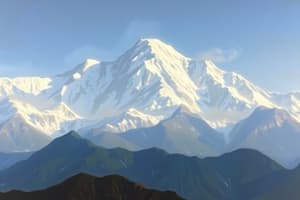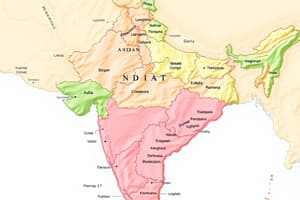Podcast
Questions and Answers
Which part of the Himalayas is known regionally as Himachal Himalaya?
Which part of the Himalayas is known regionally as Himachal Himalaya?
- Between Indus and Satluj (correct)
- Eastern boundary marked by Brahmaputra
- Between Satluj and Kali rivers
- Between Teesta and Dihang rivers
What is the name given to the region lying between the Kali and Teesta rivers?
What is the name given to the region lying between the Kali and Teesta rivers?
- Kumaon Himalayas (correct)
- Assam Himalayas
- Kashmir Himalayas
- Punjab Himalaya
Which river marks the easternmost boundary of the Himalayas?
Which river marks the easternmost boundary of the Himalayas?
- Brahmaputra (correct)
- Teesta
- Kali
- Dihang
What is the name of the area where streams disappear in a narrow belt parallel to the slopes of the Shiwaliks?
What is the name of the area where streams disappear in a narrow belt parallel to the slopes of the Shiwaliks?
Which type of soil contains calcareous deposits and is known as Kankar?
Which type of soil contains calcareous deposits and is known as Kankar?
What geological feature makes up the Peninsular Plateau?
What geological feature makes up the Peninsular Plateau?
Which mountain range in the Himalayas is known for its loftiest peaks with an average height of 6,000 metres?
Which mountain range in the Himalayas is known for its loftiest peaks with an average height of 6,000 metres?
Which range forms the longest and the most important range in the Himalayas?
Which range forms the longest and the most important range in the Himalayas?
What is the outermost range of the Himalayas called?
What is the outermost range of the Himalayas called?
Which type of sediments do the Shiwaliks in the Himalayas consist of?
Which type of sediments do the Shiwaliks in the Himalayas consist of?
What is the longitudinal valley lying between the lesser Himalayas and Shiwaliks called?
What is the longitudinal valley lying between the lesser Himalayas and Shiwaliks called?
In which direction do the Himalayan mountains run from the Indus to the Brahmaputra?
In which direction do the Himalayan mountains run from the Indus to the Brahmaputra?
Flashcards are hidden until you start studying




